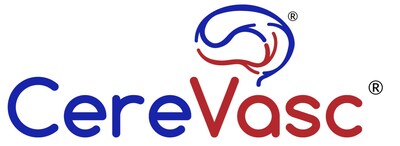- 97% of subjects treated (29/30) experienced improvement in clinical symptoms of NPH
- 0 Serious Adverse Events (SAEs) related to the study device or procedure
BOSTON, Feb. 5, 2025 /PRNewswire/ -- CereVasc, Inc., a clinical-stage medical device company developing novel treatments for neurological diseases, today reported initial results of its pilot clinical study of the eShunt® System in the treatment of elderly patients with normal pressure hydrocephalus (NPH).
This U.S. FDA approved Investigational Device Exemption (IDE) Study (ClinicalTrials.gov ID NCT05232838) is a prospective, non-randomized, open-label, multi-center study being conducted at 11 academic medical centers in the United States, in subjects with NPH for whom a traditional cerebrospinal fluid (CSF) shunt implant is indicated. The objective of the study is to evaluate the safety and efficacy of the eShunt System procedure.
CereVasc reported the study results in 30 elderly patients treated with its eShunt System in the U.S., in which the Primary Safety and Primary Efficacy Endpoints were both achieved.
Key results include:
- 97% of subjects treated (29/30) experienced improvement in clinical symptoms of NPH
- 0 Serious Adverse Events (SAEs) related to the study device or procedure
- 0 Unanticipated Adverse Device Effects were reported
- Average Length of Hospital Stay of 1.3 days
At the 90-day Primary Endpoint, no (0%) Serious Adverse Events related to the study device or procedure, and no (0%) Unanticipated Adverse Device Effects were reported. Additionally, 97% (29/30) of patients treated demonstrated improvement in the clinical symptoms of NPH; including gait improvement measured by the Timed Up and Go (TUG) test, cognitive improvement measured by the Montreal Cognitive Assessment (MoCA), and improvement in urinary symptoms as measured by the Neurogenic Bladder Symptom Score (NBSS).
“The results of this study show that an endovascular approach to treating NPH may improve overall care and clinical outcomes,” said Charles Matouk, MD, Chief, Neurovascular Surgery, at Yale New Haven Health. “A minimally invasive approach will allow us to make treatment available to more patients.”
In this study, no Serious Adverse Events (SAEs) were reported in the first 90 days. Published data on conventional open surgical shunt procedures for NPH have documented a 25.15% rate of complications or hospital readmission within 30 days of ventricular shunting. This review also documented an average hospital stay length of 3.0 days.*
“We are tremendously encouraged by these outstanding preliminary safety and efficacy results and to observe the record of rapid recovery and abbreviated length of hospital stay experienced by the subjects treated with the eShunt System,” said Dan Levangie, Chairman & CEO of CereVasc, Inc. “We are encouraged by the absence of Serious Adverse Events at 90 days combined with clinical improvement in nearly every patient, which supports our belief that an endovascular, minimally invasive treatment approach could provide significant safety and efficacy benefits, allowing a greater number of patients with this neurodegenerative disorder to receive treatment.”
About Normal Pressure Hydrocephalus
Normal pressure hydrocephalus (NPH) is most commonly seen in adults aged 60 or over. The Hydrocephalus Association estimates that 800,000 older Americans may be living with NPH, and it is estimated that more than 80% of cases remain unrecognized or untreated. Without appropriate diagnostic testing, NPH is often misdiagnosed as Alzheimer’s disease or Parkinson’s disease, the result of a stroke, or other neurodegenerative conditions. Sometimes the symptoms are mistakenly attributed to “normal aging.” NPH is, however, one of the few treatable forms of dementia.About CereVasc, Inc.
Located in Massachusetts’ healthcare hub, CereVasc, Inc., is a clinical stage, medical device company focused on the development of novel, minimally invasive treatments for patients with neurological diseases. Its initial product, the eShunt System, encompasses first-ever, groundbreaking percutaneous transvenous-transdural access to the central nervous system intended to allow the first minimally invasive treatment for communicating hydrocephalus (CH). The eShunt device concept originated from Tufts Medical Center physicians Carl Heilman, MD, Neurosurgeon and Chair Emeritus of Neurosurgery, and Adel Malek, MD, PhD, Chief of Neurovascular Surgery and Director of Cerebrovascular and Endovascular Neurosurgery. The patented eShunt System includes an endovascularly implantable cerebral spinal fluid shunt and delivery components, which are designed to treat CH without invasive surgery. For additional information, please visit our website at www.cerevasc.com.The eShunt® Device is an investigational device and has not been approved by FDA or any other regulatory agency for commercial sale. Its safety and effectiveness have not yet been fully established.
* Nadel, J.L., et. Al, NEUROSURGERY VOLUME 86 | NUMBER 6 | JUNE 2020 | 843
Company Contacts:
DJ Cass
CereVasc, Inc.
Media Contacts:
Ethan Metelenis
Precision AQ
Ethan.Metelenis@precisionaq.com
![]() View original content to download multimedia:https://www.prnewswire.com/news-releases/cerevasc-inc-announces-results-of-groundbreaking-clinical-study-of-the-eshunt-system-in-the-treatment-of-elderly-patients-with-normal-pressure-hydrocephalus-302368231.html
View original content to download multimedia:https://www.prnewswire.com/news-releases/cerevasc-inc-announces-results-of-groundbreaking-clinical-study-of-the-eshunt-system-in-the-treatment-of-elderly-patients-with-normal-pressure-hydrocephalus-302368231.html
SOURCE CereVasc






